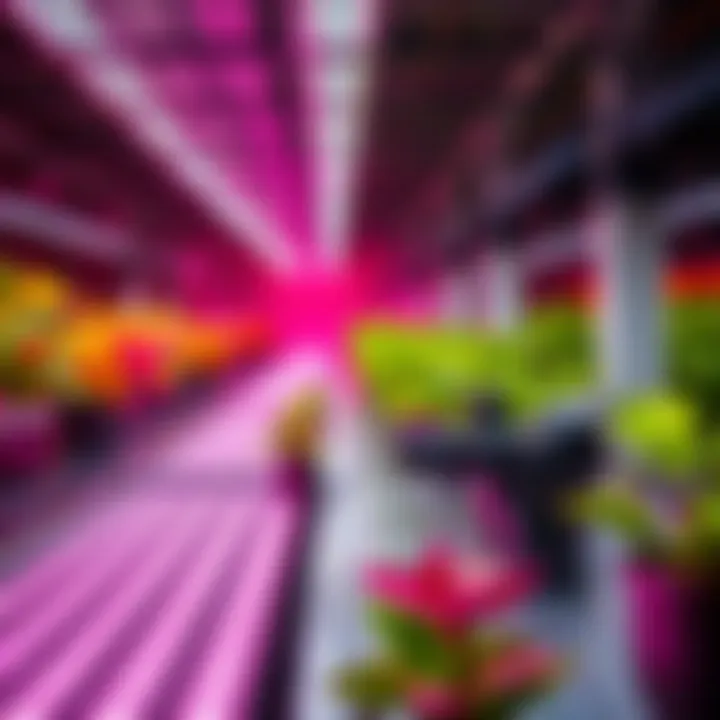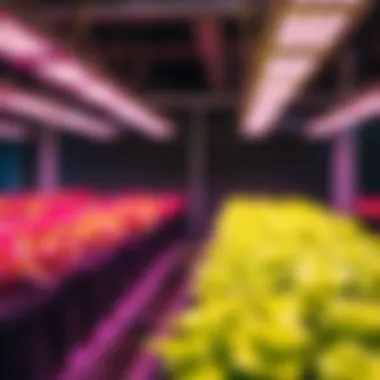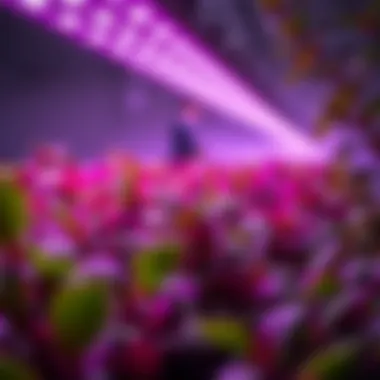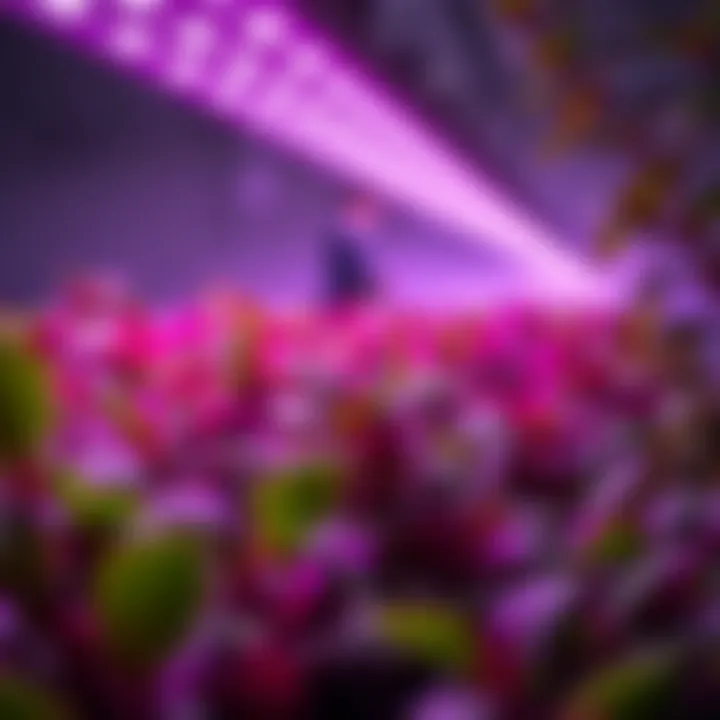Understanding Professional Grow Lights in Horticulture


Intro
In recent years, the advancements in grow light technology have sparked a transformation in horticulture. From vast commercial farms to cozy home gardens, professional grow lights are becoming a staple tool for plant enthusiasts. This article aims to shed light on the intricacies of these devices, emphasizing their importance in fostering healthy plant growth. By analyzing the science behind light, the various types of grow lights available, and their applications in different gardening settings, we will provide a comprehensive guide for both novice and experienced gardeners alike.
Latest Trends in Agriculture
The agricultural landscape is evolving rapidly, thanks in large part to innovations in technology. As farming continues to shift towards more efficient and sustainable practices, professional grow lights have become a key player in this trend.
Overview of Current Trends
Today, many farmers and horticulturists are embracing precision agriculture, which involves the use of technology to monitor and manage crop production. Professional grow lights have found a significant role in this field, allowing for crop optimization irrespective of seasonal limitations. Here are some notable trends:
- Vertical Farming: Urban spaces are leveraging vertical farming techniques where grow lights play an essential role in maximizing space usage.
- Hydroponics and Aquaponics: These soilless methods are reliant on effective lighting systems for healthy plant development, ensuring a constant food supply year-round.
- Smart Lighting Systems: The integration of IoT technology allows growers to adjust light settings based on specific plant needs, leading to improved yields.
With these trends, it's clear that grow lights are not just beneficial; they're becoming indispensable in modern agriculture.
Impact of Technology on Farming Practices
The advent of new technologies is redefining how farmers operate. As they adapt to the changing environment, grow lights have contributed significantly to this shift. Key impacts include:
- Enhanced growth rates leading to faster harvest cycles.
- Reduced energy consumption, thanks to energy-efficient LED lighting.
- Improved food quality and flavor profiles due to optimized light spectra.
Sustainable Practices: Towards a Greener Future
As the world faces challenges such as climate change and dwindling natural resources, the push for sustainable agricultural practices has grown stronger. Grow lights can enable more sustainable gardening and farming methods.
Importance of Sustainability in Agriculture
Sustainable agriculture seeks to meet current food needs without compromising future generations. Using grow lights can aid this goal by reducing land use, conserving water, and allowing year-round cultivation. By minimizing the carbon footprint associated with traditional farming methods, growers can contribute positively to the environment.
Methods for Sustainable Farming
Here are some methods that can be incorporated into the growing practices:
- Utilizing efficient LED grow lights to minimize energy consumption.
- Implementing smart systems for monitoring and adjusting light exposure based on plant needs.
- Using renewable energy sources to power grow lighting systems.
Incorporating these methods not only benefits the environment but also improves the economic viability for farmers.
Gardening Techniques and Tips
For gardeners, the right approach to using professional grow lights can spell the difference between a thriving garden and a struggling one.
Essential Gardening Tools and Equipment
In addition to grow lights, several tools can ensure effective gardening. Some essential tools include:
- Grow tents to control the growing environment.
- Timers for regulating light exposure times.
- Nutrient solutions for plant health.
These tools, when combined with grow lights, create an ideal atmosphere for plant growth, whether indoors or out.
Seasonal Gardening Practices
Adjusting gardening techniques based on the seasons can maximize the benefits of using grow lights. Some practices include:
- Starting seeds indoors under grow lights in early spring.
- Adjusting the height of grow lights as plants grow to prevent light burn.
- Creating an indoor oasis during winter to maintain productivity year-round.
By understanding and implementing these techniques, growers can truly harness the full potential of professional grow lights, leading to bountiful harvests.
"Using professional grow lights is not just about brightness; it's about creating an environment that's conducive for each unique plant species."
For a deeper look into efficient farming practices and advancements, you can visit relevant resources such as Wikipedia or Britannica. For discussions and insights, community forums like Reddit can be beneficial. Additional government and educational resources often provide research-backed data that can aid in your horticultural practices.
Prolusion to Professional Grow Lights
In an age where food security and sustainability are paramount, the importance of professional grow lights has surged dramatically in horticulture. These lights aren't just a fad; they represent a crucial strategy for optimizing plant health and productivity in various settings, from commercial greenhouses to small home gardens. The growing interest in indoor farming, paired with the challenges posed by climate fluctuations, has propelled grow lights into the spotlight.
Professional grow lights provide a simulated sunlight experience that many traditional farming methods struggle to replicate. Unlike regular bulbs, these specialized lights cater to the unique needs of plants, offering precise spectrums that promote photosynthesis. Growers no longer have to rely solely on weather patterns or seasonal changes, making it feasible to cultivate crops year-round in controlled environments.
- Benefits of Professional Grow Lights: These lights can enhance growth rates, increase yields, and ensure crops are of higher quality. They allow for targeted wavelengths, aiding in processes like germination and flowering, which are crucial at specific growth stages.
- Considerations: While the advantages are clear, it's also essential to acknowledge that choosing the appropriate type of grow light requires careful consideration. Factors such as energy efficiency, initial cost, and the specific needs of the plants must all be weighed in the decision-making process. Not all plants react the same to different light spectra, and thus understanding the individual requirements is indispensable.
Ultimately, professional grow lights pave the way for innovations in horticulture and agricultural practices. As the industry continues to evolve, these lights are set to play an increasingly pivotal role in how we approach plant cultivation, ensuring that both professionals and enthusiasts can achieve successful, sustainable farming results. With this introduction, we should now explore how light influences plant growth.
The Role of Light in Plant Growth
Light is not just a mere accessory for plants; it's at the very core of their growth and development. Understanding how light impacts plants is crucial for anyone involved in horticulture, whether you’re a commercial grower or an avid home gardener. The light plants receive directly influences their health, yield, and overall vitality.


In the realm of horticulture, light acts as both a source of energy and a signaling mechanism that directs numerous physiological processes. Without sufficient light, even the most nutrient-rich soil cannot promote optimal growth. Plants rely on light to produce energy through photosynthesis, convert carbon dioxide into carbohydrates, and stimulate various growth patterns. This connection emphasizes how integral adequate lighting is to successful plant cultivation.
A consistent supply of light can propel plants through their growth stages, especially during the critical phases of germination and flowering. Too little light can lead to weak, leggy plants that can barely stand on their own. On the other hand, appropriate light conditions can enhance flowering and fruiting capacity, leading to a more bountiful harvest. Here are a few key elements of light's role in plant growth:
- Photosynthesis: This is the process through which plants convert light energy into chemical energy, allowing them to grow and thrive.
- Light Quality: Not all light is created equal; the spectrum of light can affect different plant processes significantly.
- Light Duration: The length of time plants are exposed to light each day (photoperiod) can trigger flowering and fruiting signals.
By taking the time to understand the importance of light in plant growth, horticulturists can make informed decisions about the types of grow lights to use, how much light their plants need, and the best practices for maximizing light exposure.
Photosynthesis and Light Spectrum
Photosynthesis is often regarded as the heartbeat of plant life. It occurs primarily in the chloroplasts of plant cells, where light energy is transformed into chemical energy. The light spectrum plays a pivotal role here, as chlorophyll absorbs specific wavelengths of light to initiate this energy conversion.
- Red Light: Red wavelengths are vital during the flowering stage of many plants. They promote blooming and fruiting, making them essential for growers focusing on flowering plants.
- Blue Light: Found primarily in the early growth stages, blue light regulates chlorophyll production and helps plants grow strong, healthy leaves.
A general understanding of these light spectrums can significantly improve a grower's ability to manipulate plant growth cycles and achieve desired outcomes. For instance, using grow lights that emphasize red and blue wavelengths can enhance the overall success rate of crops while minimizing energy waste.
Influence of Light Quality on Growth
The concept of light quality extends beyond just color; it encompasses the intensity and duration of exposure as well. Research shows that light quality affects not only how plants grow but also their metabolic responses.
- Quality and Stress Tolerance: Plants exposed to diverse light wavelengths can develop better stress tolerance. This is crucial when growing in controlled environments where temperature fluctuations can be abrupt.
- Variability Across Species: Different plants have unique light needs; for example, leafy greens may thrive under a different light quality compared to fruit-bearing plants. Understanding these nuances allows growers to tailor their approach based on plant requirements.
In essence, light quality and its direct influence on crop growth can alter a grower's approach from near fixation on quantity to a more refined strategy of quality lighting. This depth of comprehension enables enhancements in yield quality and can help reduce chemical inputs often used to compensate for inadequate natural sunlight.
"A proper understanding of light spectrum and its effect on plant growth can be the difference between a thriving garden and a disappointing harvest."
To conclude, recognizing the role of light—both as a resource for energy and as a complex signaling molecule—empowers cultivators to optimize their setups. This understanding is pivotal to establishing an efficient indoor or greenhouse horticulture system.
Types of Professional Grow Lights
Grow lights come in various forms, each tailored to specific horticultural needs. Understanding the different types can significantly affect plant health, yield, and operational efficiency. This section digs into the characteristics, advantages, and limitations of various grow lights, focusing on how each type contributes to a more productive growing environment.
LED Grow Lights
LED grow lights have become a popular choice among both amateur and professional horticulturists. They offer a myriad of benefits, making them a staple in modern grow rooms.
Advantages of LED Technology
LED technology is celebrated primarily for its energy efficiency. Consuming less power allows growers to keep their electric bills manageable while still promoting vigorous plant growth. LED lights generate minimal heat, reducing the risk of overheating plants in close proximity. Besides energy savings, they provide targeted light spectra that can be customized for different growth stages, enhancing photosynthetic efficiency.
*
"LED lights are not just a fad; they represent the future of grow lighting."
*
With their long lifespan, these lights can endure for years, which translates to long-term savings. Many find the adjustable light spectra a unique trait—suitable for everything from seedling growth to flowering phases, thus ensuring optimal development.
Limitations of LED Lighting
However, LED lights aren't without their faults. The initial investment can be substantially higher compared to other lighting options. Some users also note that certain LED models may exhibit lower efficacy in the red spectrum, which is critical during specific plant growth phases. It's essential to choose models wisely and weigh these disadvantages against their overall benefits, especially for beginners who may find high upfront costs daunting.
Fluorescent Grow Lights
Fluorescent lights have long been a go-to for many indoor gardeners, especially for seedlings and leafy greens. Their effective output and affordability make them an appealing option.
Types of Fluorescent Bulbs
These grow lights come in various shapes, including T5, T8, and compact fluorescent lamps (CFL), each designed to meet diverse needs. T5 bulbs, for instance, provide a high light output with relatively low energy consumption, making them a favorite among many growers. They're particularly beneficial for vegetative growth and can be placed closer to plants without risking heat damage.
Best Use Cases
The best application for fluorescent grow lights lies in starting seedlings or growing tender annuals. Their low heat output allows for intensive use without stress on delicate plants. However, they do have limitations when it comes to flowering plants since they typically don't provide the full spectrum of light needed for robust bloom production. For growers focused primarily on vegetative stages, they're incredibly useful, but for flowering or fruiting plants, supplemental lighting may be required.
High-Intensity Discharge (HID) Lights
HID lights are known for their strength and intensity, making them suitable for larger scale operations where light distribution is paramount.
Metal Halide vs. High-Pressure Sodium
Each type of HID light offers distinctive benefits: Metal Halide (MH) lights emit a blue spectrum that promotes vegetative growth, while High-Pressure Sodium (HPS) lights provide a red spectrum that enhances flowering. This duality allows growers to switch between them based on the growth stage of their plants, offering flexibility not easily found in other light types.
Considerations for Use
Despite their effectiveness, HID lights require more energy and generate significant heat. This means the need for ventilation and cooling systems becomes more pronounced for regular usage. For growers with reliable cooling solutions, HID lights can offer robust yields but their operational costs and heat management must be carefully navigated to ensure optimal growth conditions.
Incandescent Grow Lights


Though not as commonly used today, incandescent lights still have their place in the gardening world.
Benefits and Drawbacks
The primary benefit of incandescent lights is their low initial cost and availability. They can work well for very short-term uses, like supplementary lighting in a pinch. However, they are highly inefficient compared to other technologies, wasting a significant portion of energy as heat rather than light. As such, they can lead to increased costs in the long run.
Efficient Alternatives
For those still reliant on incandescent lighting, several alternatives can suit specific applications better. Incandescent lights can be replaced with compact fluorescent lamps or LEDs, which offer better energy efficiency. Those who decide to upgrade will see not just lower bills but also healthier plants, benefitting from optimized light conditions.
In summary, knowing the differing types of professional grow lights and their specific pros and cons is vital for any horticulturalist looking to enhance their growth strategies. Each lighting technology presents a unique set of features, and making an informed choice will ensure that plants are nurtured in the best possible conditions.
Selecting the Right Grow Light for Your Needs
Choosing the appropriate grow light can indeed feel like navigating through a labyrinth; there’s a myriad of options that might be more or less suited for individual plant needs. Making informed choices not only leads to healthier plants, but it also can save time and resources. When engaging in horticulture, understanding this topic is crucial as it dictates the overall success of your gardening efforts, whether you’re an experienced farmer or just starting out in home gardening.
Assessing Light Requirements
One cannot underestimate the importance of knowing the specific light needs of the plants you are nurturing. Light requirements can vary remarkably between plant species. For instance, some plants thrive in low-light conditions, while others crave full sun.
To evaluate light needs, consider these factors:
- Plant Type: Research each variety. For example, succulents often need strong, direct light, while ferns may prefer indirect lighting.
- Growth Stage: Seedlings and mature plants often require different light intensities. Generally, young plants do well under softer light, whereas mature ones usually demand brighter conditions.
- Seasonal Adjustments: Plants can have seasonal fluctuations in light needs. In winter, lower natural light may necessitate supplemental grow lighting to ensure robust growth.
Utilizing light meters can enhance your assessment. It can help gauge the actual light intensity in your growing environment, letting you tailor your grow light selection accordingly.
Understanding Coverage Area
After pinpointing your plants' light requirements, the next step is to figure out the coverage area of your grow lights. This aspect is vital because if you aim for effective growth, each plant must receive adequate light.
Lights come with varying coverage specifications. Factors to consider include:
- Light Type: For example, LED lights often provide directional light, meaning you’ll need to consider their placement carefully to cover all plants effectively. On the other hand, fluorescent lights provide a wider spread but may lack intensity.
- Grow Space Size: Measure your growing area. The dimensions influence how many lights you will need and where to place them.
- Height and Angle: The distance between the light source and the plants affects the intensity. Higher placements might diffuse light too much whereas lower placements might burn the plants.
"Understanding how to match your grow lights with the right coverage area ensures no plant is left out in the dark."
Incorporating adjustable or flexible lighting systems can be a wise choice. This way, as plants grow, you can modify the light height and angles to accommodate their changing needs.
By taking these elements into consideration, one can ensure a more robust and thriving horticulture environment, leading to lush growth and, ultimately, higher yield.
Energy Efficiency and Cost Considerations
When it comes to growing plants, especially in a controlled environment like a greenhouse or indoor garden, the efficiency of your chosen grow lights can spell the difference between flourishing crops and wilted greens. Energy efficiency isn’t just a buzzword; it’s a significant factor that can directly affect your operational costs, crop yield, and the overall sustainability of your gardening practice. By understanding how to evaluate energy consumption and assess long-term costs, growers can make informed decisions that lead to both effective and economical results.
Evaluating Energy Consumption
To better appreciate energy efficiency, one must first grasp how power consumption pairs with plant growth. Each type of grow light has a unique wattage, and knowing how much energy each variant consumes is foundational. In general, LED lights are touted as the frontrunners in this arena. Their low wattage translates into less power draw while still providing ample light for photosynthesis.
Here are a few key aspects to consider when evaluating energy consumption:
- Wattage: This is a direct measurement of how much electricity your grow lights utilize. Lower wattage usually means lower costs, although other factors come into play.
- Lifespan: Some lights, like LEDs, last significantly longer than traditional modes. This longevity can dramatically affect total energy costs.
- Heat Generation: More energy consumed turns into heat, which can require additional cooling solutions, further raising operational expenses.
In practice, a grower might compare an LED light drawing 100 watts to a fluorescent light drawing 200 watts. The former will not only save on energy bills, but less heat means potentially lower cooling costs too.
Long-Term Cost Analysis
When pondering your investment in grow lights, a short view may lead to oversights. While initial costs matter, the long-term financial implications can often tell a different story. Understanding the physics of grow lights allows you to break down total cost of ownership over time.
One must consider several factors in a long-term cost analysis:
- Upfront Costs: This includes the purchase price of the grow lights and any supporting infrastructure.
- Operation Costs: Regular energy bills constitute a significant factor here. It’s crucial to use estimates based on your expected usage patterns.
- Maintenance and Replacement: Some lights will require more frequent bulb replacements or maintenance, impacting the budget in the long run.
For instance, while a high-intensity discharge (HID) light might come cheaper initially, its higher energy requirements and shorter lifespan could yield elevated costs over five years compared to LEDs, which may have higher upfront costs but lower operation and maintenance expenses.
Additionally, it’s worth pondering the environmental aspect. A grow light strategy that’s more energy-efficient isn’t just better for your wallet, but for the planet—reducing carbon footprints and conserving resources.
"The best way to predict the future is to create it."
— Peter Drucker
In an age where every penny matters, savvy growers must make cost-conscious choices about their light systems while considering yield, quality, and sustainability. With knowledge of both immediate and long-term financial impacts, you stand equipped to make smarter decisions for your horticultural endeavors.
For more context, you can explore these resources:
Best Practices for Using Grow Lights
When it comes to maximizing the efficiency of grow lights, understanding and implementing best practices is key. These practices not only ensure that plants receive optimal light exposure, but they also help in reducing operational costs and extending the lifespan of the lighting equipment. Keeping your plants happy is no walk in the park, and knowing how to manage lumens effectively can take your growth efforts to the next level.


Spacing and Positioning
The spacing and positioning of grow lights can be likened to finding the perfect sweet spot in a dance. Too far away, and your plants will starve for light; too close, and they might suffer from light burn. Generally, it’s wise to follow the manufacturer’s recommendations for distance, but factors like the type of light used and the species of plants you're growing can tweak those general guidelines.
- Understand Your Light Type: For instance, LED lights can be placed closer to plants than HID lights due to their lower heat output.
- Consider Plant Growth Stage: Young seedlings might require less intense light than mature plants. Adjust accordingly.
- Aim for Adjustable Height: Invest in hanging systems that allow you to easily raise or lower your lights. It’s much easier to adapt than to uproot your plants.
As a rule of thumb, start with a height that gives your plants enough coverage without frying them. Monitor plant responses, and adjust as necessary. Keep things flexible—what works one week might need a rethink the next.
Timing and Duration of Light Exposure
Setting up a light schedule might feel akin to setting an alarm clock that won�’t stop ringing, but it’s a crucial part of horticulture. The timing and duration of light exposure have significant effects on plant growth cycles, so it pays to nail it down right.
- Follow Natural Light Cycles: Mimic day and night cycles. Most plants thrive with about 12 to 16 hours of light per day. Conversely, some plants may need nearly 24 hours of light, especially in their initial growth stages.
- Use Timers: Invest in timers that automate your light cycles. This way, you avoid the human error of forgetting to switch the lights on or off. Consistency is queen.
- Watch for Signs of Stress: If plants start stretching toward the light excessively, it may mean they're hungry for more exposure. On the flip side, if they begin to yellow, you might be overdoing it.
"In horticulture, perfect timing isn’t just a concept; it’s a principle that can mean the difference between lush growth and withering leaves."
To summarize, understanding how to space, position, and time your grow lights can drastically improve your horticulture efforts. Knowing these practices not only boosts the success of your plants but also fosters a productive and satisfying gardening experience. For further insights on grow light management, consider exploring resources such as Wikipedia or articles provided by University Extensions.
Challenges and Limitations of Grow Lights
Understanding the challenges and limitations of grow lights is essential for anyone looking to maximize plant growth and health indoors. While grow lights have revolutionized horticulture, they aren’t without their hurdles. An awareness of these issues aids growers in making informed decisions and optimizing the use of light technologies.
Common Issues in Indoor Lighting
When it comes to indoor horticulture, light quality and accessibility can bring about a variety of complications. One of the primary concerns is the inconsistent distribution of light. Unlike natural sunlight, which diffuses evenly across a wide area, most artificial grow lights emit concentrated beams. This can lead to uneven growth, where some plants flourish while others struggle due to insufficient exposure.
Another common issue is heat buildup. Professional grow lights, such as High-Intensity Discharge (HID) and even some LED systems, can generate substantial heat. This can not only stress plants but also significantly increase cooling costs, especially in tight growing spaces. Burnt leaves or stunted growth could be indicators of this problem. Regular monitoring and adjustments are necessary to avoid these pitfalls.
"The right kind of light can make the difference between a thriving plant and a disappointing yield."
Additionally, light pollution can pose challenges. For urban growers, using certain types of indoor lighting may lead to spillover into the surrounding environment, disrupting the local ecosystem and attracting unwanted attention.
Potential Health and Environmental Concerns
The use of grow lights also brings up important health and environmental considerations. First off, there’s the issue of electromagnetic radiation. Some light sources release radiation that may have adverse effects on both humans and the local wildlife. Awareness and precautions, such as using shielding techniques or safety glasses, can mitigate these risks.
Moreover, as indoor farming grows in popularity, energy consumption becomes a vital concern. While energy-efficient models have hit the market, excessive use of grow lights can still have a hefty carbon footprint. The environmental impact isn’t just limited to energy usage, though.
In addition to this, many conventional bulbs contain materials that can be hazardous when disposed of improperly. For instance, fluorescent tubes contain mercury, which requires careful handling during disposal to avoid environmental contamination. Thus, adopting a sustainable disposal routine is crucial.
Future Trends in Grow Light Technology
The evolution of grow light technology serves as a cornerstone for horticulture's future, promising enhanced efficiency and productivity for growers ranging from home gardeners to commercial farmers. The importance placed on future trends cannot be overstated; as the demand for high-quality produce increases, understanding these trends allows growers to keep pace with innovations that offer better yields, energy savings, and ease of use. New developments in this field address gaps that traditional lighting systems have struggled with, bridging the divide between low-energy consumption and optimal plant growth.
Key elements surrounding future trends include:
- Improved light quality and spectrum precision
- Smart technology integration for enhanced monitoring and control
- Energy-efficient designs while maintaining productivity
As these advancements unfold, growers will need to remain informed and adaptable, ensuring that they leverage these technologies to foster healthier plant growth and more sustainable practices.
Advancements in Light Spectrum Engineering
In recent years, there has been a concerted effort towards fine-tuning the light spectrum emitted by grow lights. This shift is based on an understanding that different plants have varied light requirements at different growth stages. For instance, seedlings benefit from a spectrum that features higher blue light, while flowering plants thrive under red light the most.
Recent advancements in light spectrum engineering have led to developments such as:
- Full-spectrum LEDs that closely mimic natural sunlight, catering to all plant stages.
- Adjustable spectrum features that allow users to modify light wavelengths based on specific crop needs or growth phases.
- Dynamic lighting systems, where the light spectrum changes throughout the day, emulating natural sunlight patterns that aid in processes like flowering and fruiting.
These innovations indicate a shift towards a customized lighting approach that can maximize yield while minimizing resource use, leading to more sustainable horticultural practices. Growers can now specify requirements based on the unique needs of their plants, optimizing growth and enhancing overall quality.
Integration with Smart Technologies
As technological advancements permeate various sectors, horticulture is no exception. The integration of smart technologies into grow light systems is transforming traditional gardening and farming practices. By employing sensors and automated systems, growers can monitor light intensity, duration, and spectrum in real-time.
Here are some key benefits of integrating smart technologies with grow lights:
- Remote monitoring and control, allowing growers to adjust settings via smartphones or computers, thus optimizing conditions without being physically present.
- Data analytics, which can forecast plant needs by analyzing environmental conditions and growth patterns, helping to predict the best times for light exposure.
- Collaboration with other smart farming equipment, ensuring that nutrient delivery, moisture, and light are synchronized for optimal plant health.
The convergence of smart technologies with grow lights not only enhances efficiency but also promotes a greater understanding of plant biology, paving the way for more informed decision-making.
"In the world of horticulture, staying ahead of the technological curve is no longer a luxury; it's a necessity for sustainable growth and success."
By keeping an eye on emerging trends, growers can harness these advancements to not just meet the demands of the market but to also possibly outpace it with superior products.
Ending
The conclusion in this article sheds light on the essential role that professional grow lights play in the ever-evolving realm of horticulture. As we've examined through various angles, the significance of these artificial lighting systems cannot be overstated. Whether nurturing delicate seedlings or optimizing the growth of fully established plants, grow lights have transformed the way horticulturists approach cultivation, especially in settings where natural light is scarce or unreliable.
One of the core benefits of utilizing professional grow lights is their ability to customize light conditions according to specific plant requirements. Different species rely on varying spectra of light for optimal photosynthesis; thus, having control over light quality is paramount. By adjusting the color temperature and the duration of light exposure, growers can mimic seasonal changes, effectively enhancing growth rates and yield. This adaptability can mean the difference between a mediocre harvest and a bounteous one.
Moreover, the energy efficiency of modern grow lights plays a pivotal role in making horticulture sustainable and cost-effective. With the advancements in technology such as LED grow lights, growers can achieve substantial savings on energy bills while still providing their plants with the light they need to thrive. In the long run, this not only benefits the bottom line but also minimizes environmental impact.
However, it's not just about choosing the right grow light. Mastering the timing of light exposure and understanding the physical spacing of lights in relation to plant height and layout are factors that contribute significantly to successful cultivation. These considerations, which might seem trivial, can greatly affect plant health and growth dynamics.







